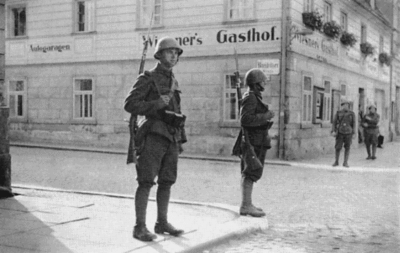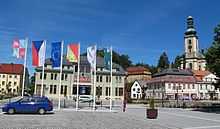Krásná Lípa
| Krásná Lípa | |||
| Town | |||
|
|||
| Country | Czech Republic | ||
|---|---|---|---|
| Region | Ústí nad Labem | ||
| District | Děčín | ||
| Commune | Rumburk | ||
| Elevation | 426 m (1,398 ft) | ||
| Coordinates | 50°54′48″N 14°30′32″E / 50.91333°N 14.50889°ECoordinates: 50°54′48″N 14°30′32″E / 50.91333°N 14.50889°E | ||
| Area | 31.39 km2 (12.12 sq mi) | ||
| Population | 3,644 | ||
| Density | 116 / km2 (300 / sq mi) | ||
| First mentioned | 1361 | ||
| Mayor | Jan Kolář | ||
| Timezone | CET (UTC+1) | ||
| - summer (DST) | CEST (UTC+2) | ||
| Postal code | 407 46 | ||
  Location in the Czech Republic
| |||
| Wikimedia Commons: Krásná Lípa | |||
| Statistics: statnisprava.cz | |||
| Website: www.krasnalipa.cz | |||
Krásná Lípa (Czech pronunciation: [ˈkraːsnaː ˈliːpa]; German: Schönlinde) is a town in the Ústí nad Labem Region of the Czech Republic. It has c. 3,500 inhabitants.
History
In 1361, a settlement was recorded on the Tollenstein (Tolstejn). Later, about 30 families from Upper Franconia (Germany) colonized the place. In 1654 the community had 36 farm houses and 60 craftsman houses, mainly linen weavers. John Barnes, an English expert on textile industry, was hired in 1731 to found a spinning factory in the town.
Economic development was further stimulated by the construction of the railway in 1869 and on 5 January 1870 Krásná Lípa became a corporate town. In 1910 the town reached its greatest population, with 6930 inhabitants. Along with other parts of the former Austrian Empire, Schönlinde became part of Czechoslovakia in 1919, now called Krásná Lípa, after having been attached to German Austria for some months.

Notice the German language used by the country inn in the background.
The expulsion of Germans after World War II in 1945–1946 reduced the population by half and more than 300 deserted houses were demolished, others dilapidated. One of the Germans who was deported from the Sudetenland was Gerhard Mitter, then age 10, who would become a race driver for Porsche.

External links
- (Czech)(German)(English) Municipal website
| Wikimedia Commons has media related to Krásná Lípa. |

